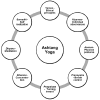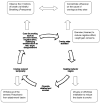A narrative review of yoga and mindfulness as complementary therapies for addiction
- PMID: 23642957
- PMCID: PMC3646290
- DOI: 10.1016/j.ctim.2013.01.008
A narrative review of yoga and mindfulness as complementary therapies for addiction
Abstract
This paper reviews the philosophical origins, current scientific evidence, and clinical promise of yoga and mindfulness as complementary therapies for addiction. Historically, there are eight elements of yoga that, together, comprise ethical principles and practices for living a meaningful, purposeful, moral and self-disciplined life. Traditional yoga practices, including postures and meditation, direct attention toward one's health, while acknowledging the spiritual aspects of one's nature. Mindfulness derives from ancient Buddhist philosophy, and mindfulness meditation practices, such as gentle Hatha yoga and mindful breathing, are increasingly integrated into secular health care settings. Current theoretical models suggest that the skills, insights, and self-awareness learned through yoga and mindfulness practice can target multiple psychological, neural, physiological, and behavioral processes implicated in addiction and relapse. A small but growing number of well-designed clinical trials and experimental laboratory studies on smoking, alcohol dependence, and illicit substance use support the clinical effectiveness and hypothesized mechanisms of action underlying mindfulness-based interventions for treating addiction. Because very few studies have been conducted on the specific role of yoga in treating or preventing addiction, we propose a conceptual model to inform future studies on outcomes and possible mechanisms. Additional research is also needed to better understand what types of yoga and mindfulness-based interventions work best for what types of addiction, what types of patients, and under what conditions. Overall, current findings increasingly support yoga and mindfulness as promising complementary therapies for treating and preventing addictive behaviors.
Copyright © 2013 Elsevier Ltd. All rights reserved.
Conflict of interest statement
Figures
Similar articles
-
Mindfulness-based treatment to prevent addictive behavior relapse: theoretical models and hypothesized mechanisms of change.Subst Use Misuse. 2014 Apr;49(5):513-24. doi: 10.3109/10826084.2014.891845. Subst Use Misuse. 2014. PMID: 24611847 Free PMC article. Review.
-
Cluster Randomized Controlled Trial of a Standard Versus Postures-Only Yoga Session: Potential Self-Regulatory and Neurophysiological Mechanisms of an Ancient Practice.Ann Behav Med. 2024 Oct 18;58(11):707-716. doi: 10.1093/abm/kaae057. Ann Behav Med. 2024. PMID: 39313441 Clinical Trial.
-
Meditation Awareness Training for the Treatment of Sex Addiction: A Case Study.J Behav Addict. 2016 Jun;5(2):363-72. doi: 10.1556/2006.5.2016.034. Epub 2016 Jun 27. J Behav Addict. 2016. PMID: 27348560 Free PMC article.
-
The Effects of Mindfulness Meditation and Gentle Yoga on Spiritual Well-Being in Cancer Survivors: A Pilot Study.Altern Ther Health Med. 2021 May;27(3):32-38. Altern Ther Health Med. 2021. PMID: 33128538
-
Meditation-based mind-body therapies for negative symptoms of schizophrenia: Systematic review of randomized controlled trials and meta-analysis.Schizophr Res. 2019 Oct;212:15-25. doi: 10.1016/j.schres.2019.07.030. Epub 2019 Aug 1. Schizophr Res. 2019. PMID: 31378557
Cited by
-
Effectiveness of brief mindfulness intervention for college students' problematic smartphone use: The mediating role of self-control.PLoS One. 2022 Dec 22;17(12):e0279621. doi: 10.1371/journal.pone.0279621. eCollection 2022. PLoS One. 2022. PMID: 36548308 Free PMC article. Clinical Trial.
-
Prevalence of Alcohol and Tobacco Use in India and Implications for COVID-19 - Niyantrita Madhumeha Bharata Study Projections.J Med Life. 2020 Oct-Dec;13(4):499-509. doi: 10.25122/jml-2020-0079. J Med Life. 2020. PMID: 33456598 Free PMC article.
-
Evaluation of Yoga for Preventing Adolescent Substance Use Risk Factors in a Middle School Setting: A Preliminary Group-Randomized Controlled Trial.J Youth Adolesc. 2017 Mar;46(3):603-632. doi: 10.1007/s10964-016-0513-3. Epub 2016 May 31. J Youth Adolesc. 2017. PMID: 27246653 Free PMC article. Clinical Trial.
-
"Smoking Does Not Go With Yoga:" A Qualitative Study of Women's Phenomenological Perceptions During Yoga and Smoking Cessation.Int J Yoga Therap. 2016 Jan;26(1):33-41. doi: 10.17761/1531-2054-26.1.33. Int J Yoga Therap. 2016. PMID: 27797659 Free PMC article.
-
Information Needs of Addicted Individuals: A Qualitative Case Study.Addict Health. 2021 Jul;13(3):138-147. doi: 10.22122/ahj.v13i3.312. Addict Health. 2021. PMID: 35140892 Free PMC article.
References
-
- World Health Organization (WHO), Global Health Observatory (GHO) [8/31/2012]; Available at: http://www.who.int/gho/substance_abuse/en/index.html.
-
- Brandon TH, Vidrine JI, Litvin EB. Relapse and relapse prevention. Annu Rev Clin Psychol. 2007;3:257–284. - PubMed
-
- Miller WR, Westerberg VS, Harris RJ, Tonigan JS. What prevents relapse? Prospective testing of antecedent models. Addiction. 1996;91(Suppl):S155–172. - PubMed
-
- Fortney L, Taylor M. Meditation in medical practice: A review of the evidence and practice. Prim Care Clin Office Pract. 2010;37(1):81–90. - PubMed
Publication types
MeSH terms
Grants and funding
LinkOut - more resources
Full Text Sources
Other Literature Sources



